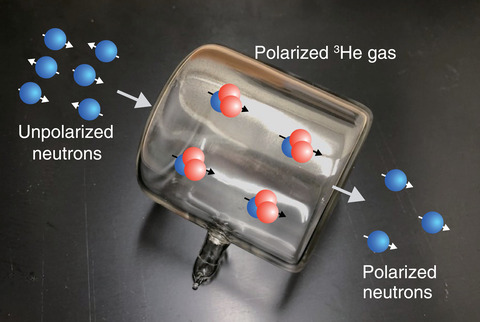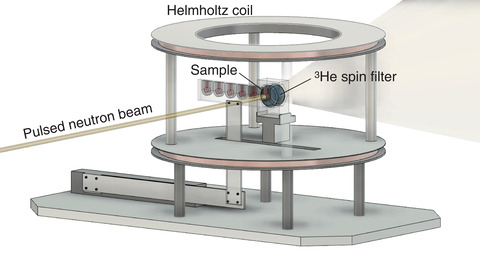
Fig.5-5 Fabricated 3He spin filter

Fig.5-6 Instrument used for neutron polarization analysis that uses the 3He spin filter in a small-angle neutron scattering experiment
Neutrons have important characteristics such as having no electric charge, high transmittance, and a large cross-section for light elements, as well as having a spin. However, magnetic supermirrors, widely used to polarize neutrons, can only polarize neutrons below several tens of meV. The pulsed neutron source at the Materials and Life Science Experimental Facility in J-PARC can provide neutrons across a wide energy range (from 1 meV to 1 keV), unlike reactor neutron sources.
To further broaden this range, we developed a 3He spin filter, which is a neutron polarization device comprising nuclear spin-polarized gaseous 3He encapsulated in a glass cell (Fig.5-5). The 3He spin filter can polarize neutrons with energies ranging from 1 meV to 10 eV by adjusting the amount of 3He gas and is suitable to analyze the spin of neutrons scattered by a sample due to its large solid angle coverage. The key to developing this device was determining how to polarize the 3He gas with a high polarization ratio while maintaining the polarization on the neutron beamline. Since impurities in the glass cell reduce the 3He polarization, we constructed a vacuum system to supply 3He gas to the glass cell while minimizing contamination. A laser irradiation system of approximately 100 W was also constructed to polarize the 3He gas. Finally, the developed 3He spin filter demonstrated a 3He polarization of 85%, representing the highest documented neutron polarization. Generally, 3He polarization gradually decreases when laser irradiation is stopped due to impurities inside the glass cell and the surrounding non-uniform magnetic field. Therefore, we established a gas filling procedure to remove impurities inside the glass cell and developed a uniform magnetic field environment on the beamline to maintain a long-lasting 3He polarization.
The developed 3He spin filter was installed in beamlines BL04, BL06, BL10, BL15, and BL21, and experiments using neutron beams were performed. A neutron beam of approximately 1 eV was successfully polarized in BL04: Accurate Neutron-Nucleus Reaction measurement Instrument (ANNRI); this allowed us to discover the angular distribution of the γ-rays emitted in the polarized neutron absorption reaction of 139La. Additionally, we verified that neutron polarization analysis using the 3He spin filter can be used to determine the position of hydrogen atoms in materials in pulsed neutron small-angle scattering experiments (Fig.5-6) during experiments performed using the small and wide-angle neutron scattering instrument “TAIKAN” (BL15). Many experiments using 3He spin filters have since been performed, and various scientific results are expected to be obtained in the future.
(Takuya Okudaira)